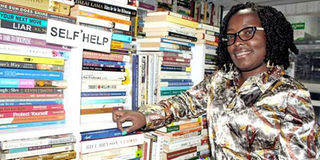Bookshop owner doesn’t buy the dubious Kenyans-don’t-read song

Mercy Kibira, the proprietor of Half-priced Books, at her bookshop on Moi Avenue in Nairobi. PHOTO | LUCY WANJIRU | NATION MEDIA GROUP
What you need to know:
The description on Mercy’s Instagram profile says #kenyansread. I like that hashtag.
It is so precise yet so contrary to what is touted about our reading culture as Kenyans.
No one quite recalls where this notion was birthed but Halfpriced Books is keen to dismantle it.
I pull out a book from one of the shelves of Halfpriced Books bookshop. Memoirs of a Geisha, the novel by Arthur Golden. Its pages smell of musky storage, mawkish sentiments and a textured personality. It smells old. It smells like an old book that was never new.
20,000 BOOKS
Pencilled on its first page is the name, I suppose, of its previous owner: Corrine Benedek. You can only find such handwritten inscriptions in bookstores such as this.
Mercy Kibira sells such pre-owned books from her bookstore at Bihi Towers, in the Nairobi city centre.
They stock all genres, including children’s books. Her business partner in the US ships them every quarter. He ships at least 20,000 books in a container.
As its name suggests, Halfpriced Books sells its books at half the price of what a similar new book would cost. The novel I pull out is Sh500. All titles dance around that range.
The description on Mercy’s Instagram profile says #kenyansread. I like that hashtag. It is so precise yet so contrary to what is touted about our reading culture as Kenyans. No one quite recalls where this notion was birthed but Halfpriced Books is keen to dismantle it.
This is Mercy’s story:
My dad thought I had gone crazy. What business did I have launching a business that sold pre-owned books? To who? Where? Ha-ha. I thought I was crazy, too. I graduated with a degree in economics from Kenyatta University. At 27, I imagined I’d be employed in a bank and wearing suits.
I never imagined I’d be selling pre-owned books and donating them to schoolchildren.
I grew up in Elburgon town and there were no storybooks to read in school. I have five siblings, and I’m blessed that Dad could afford to buy me books to read at home. Thinking about not having books as a child drives me to donate to schoolchildren in marginalised communities.
My goal is to read 52 books this year, that’s one book a week. I am currently reading Balanced Scorecard by Robert Kaplan and David Norton because I need to polish my business acumen.
WELL-DISPLAYED
Last week I read Warsan Shire’s Teaching My Mother How to Give Birth. It is an amazing book about female empowerment. Every woman should read it.
Our direct competitors are the book vendors on the streets. The inamas.
What gives us our edge is that our books are well-displayed on the shelves and there is time to browse the titles.
I am also a voracious reader, I cherry-pick the titles that end up on our shelves. Our soon-to-launch website will enhance browsing.
Our casuals remove the 20,000 books from the container, into a lorry for dispatch to our warehouse in Ruiru.
This is where the books are sorted according to category, and repacked for distribution. It takes up to two weeks to sort one container. I decide which books we’ll donate and which we’ll sell.
See more photos of our titles on our Instagram page, @halfpriced_books.
EVERY DAY
I am able to get through a book a week because I only read books that excite me. No one should struggle through a boring book!
If a book doesn’t excite you, put it aside and pick up another one. There are a million other titles out there.
The last book I put aside was Why Nations Fail by Daron Acemoglu and James Robinson. It is a political book. Politics doesn’t excite me.
The downside with selling pre-owned books is that you can’t promise your clients a title. We sell what we get from the container, what ends up in the container is what my partner ships from the US. He only ships what is available.
Bookshops that sell new books can offer their clients this surety.
I read for at least an hour every day. I am a night owl but I sometimes read in the morning.
TARGET CLEINTS
My reading nook is a swinging chair in the corner of my living room. I like to curl up there with a cup of black lemon tea. Here, let me show you a photo.
Nothing and no one can pull me out of that chair when I’ve sat down to read.
I have discovered that it’s only people who don’t read who say Kenyans don’t read.
I know this for a fact because of the overwhelming response we’ve received on social media and the titles we sell per week.
Truth is, Kenyans read.
My target audience is students, middle-class and low-income earners. People who loved to read but can’t afford the brand-new books in bookshops.
I remember when I was in campus and I really wanted NoViolet Bulawayo’s novel We Need New Names. That Sh1,200 was pocket money, not book money.
PERSONAL INTERESTS
One way to build a reading culture in adults is to have people read books aligned to their personal interests.
Or ask them who inspires them, then get them that person’s autobiography.
People are likely to maintain the reading habit when the story interests them.





